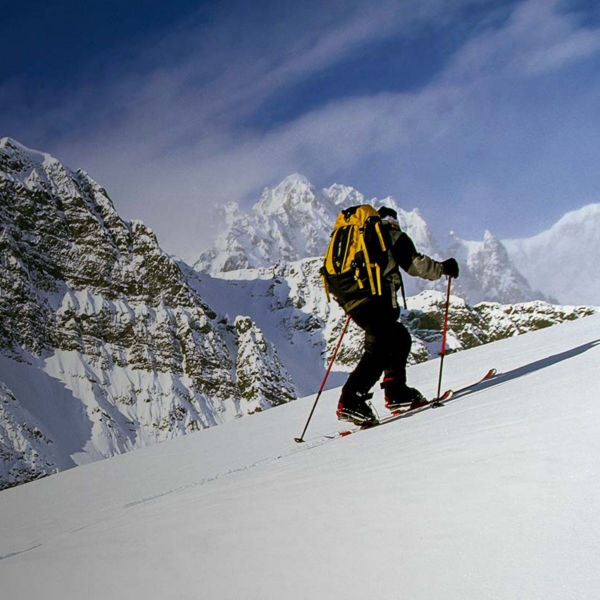
You may have skis, skins, touring boots, and bindings, but you’re not ready to start backcountry skiing or splitboarding until you also have a few key essentials for backcountry safety.
There are plenty of differences between skiing or riding at the resort versus heading into the backcountry. In the backcountry, there’s the deeper solitude, untouched snow, and amazing scenery. But there’s also the threat of avalanches, which makes the backcountry a different world. Ski resorts actively manage their snow to prevent avalanches. Beyond their bounds, you’ll have to rely on your knowledge of the terrain and the conditions—and your gear—to stay safe.
Before you start backcountry skiing or splitboarding, make sure you take at least a Level 1 American Institute for Avalanche Research and Education (AIARE) course for avalanche education and awareness. These intensive courses, usually two to three days in length, are amazing ways to learn the ins and outs of managing risk in the backcountry. They’ll also teach you how to use your backcountry safety gear: your avalanche beacon, probe, and shovel. These three items are the bare essentials, but a smart backcountry safety plan can also include bringing along radios for in-group communication, a personal locator device for emergencies, and/or an avalanche airbag.
Here’s a look at some of the main categories of backcountry safety gear and how to choose the right options to help keep you—and your partners—safe.
Beacons
Beacons represent some of the coolest advances in avalanche safety technology over the last decade. Today, these digital devices (sometimes called transceivers) are able to pinpoint buried beacons with amazing accuracy, helping skiers and riders locate avalanche victims quickly. Beacons these days are lighter and more compact than ever, but different models offer different features. Here are some things to look for.
Features
Many modern beacons offer features like LED displays, signal locking, signal suppression for multiple-burial searching, and more. Look for a display that’s easier for you to read and use. Most beacons also come with chest or shoulder harnesses. These are nice for easy access and security—and a must if your baselayer or bibs don’t have a secure inner pocket.
Antennae
These days, all new digital beacons come with three antennae for pinpoint search accuracy in triangulating signals. You can still find used beacons with just two antennae but try to steer clear of those—the modern, three-antennae versions are more reliable.
How to Choose
A slew of beacons exist for all levels of use, with varying price points, so it’s important to decide on your goals before purchasing. Will you just ski or ride a handful of times each winter in relatively safe terrain? If so, you might want a simpler, less expensive model that prioritizes price, speed and ease of use—which most new users are gravitating to. Are you heading out regularly in larger groups or in more advanced terrain? In that case, you might want a more expensive beacon with more bells and whistles, such as multiple-burial/big picture modes.
The good news: All brands are compatible and most new beacons from major suppliers are smaller than their predecessors, with enhanced usability, LED displays, range, search speed, sound amplification stages, and more.
But the most important thing? Just get one. It’s hard to overstate the importance of a beacon when it comes to avalanche safety. As the experts say, the best beacon is the one you know how to use. (Pro tip: Also be sure to practice using it. Find a beacon park at your home resort or conduct regular drills with your friends to keep your search skills fresh.)
Shovels
Avalanche shovels these days are stronger, lighter, and more compact than ever, virtually eliminating all excuses not to carry one in your pack. After all, even the fanciest beacon is worthless if you can’t dig out a victim. Shovels are also useful for other safety applications—like digging snow pits to evaluate slope stability.
Materials
When an avalanche comes to a stop, its blocks of snowy debris set up like concrete, making it extremely difficult to dig through. That means you need a really sturdy shovel if you want to reach a buried victim in time. Metal, therefore, is much better than plastic; most avalanche shovels are made from aluminum, which has a great strength-to-weight ratio. If you must save weight, you can opt for a carbon shaft, though they tend to be more expensive.
Blade
Shovel blades vary in shape, size, and style. Larger blades move snow faster, but take more strength to use; smaller blades are lighter, but less efficient. Also consider your pack size: Nearly all avalanche shovels feature detachable handles, but you’ll still need to make sure your pack is wide enough to accommodate the blade.
Most blades are slightly curved and are either flat or serrated. Serrated blades are better for cutting through hard snow, But if you plan on digging a lot of snow pits, flat blades create a smoother wall for analyzing snowpack. Some blades feature holes, which make them lighter and allow you to use them for snow anchors, rescue sleds, and other uses often relied upon by guides and patrollers.
Shafts, Handles, and Grips
Most shovels have telescoping shafts designed to deploy quickly and easily with the press of a button. Longer shafts offer more leverage (but are heavier), while shorter shafts can be used in tighter quarters. Some shafts have an oval-shaped diameter, making them stronger. For size, make sure the shovel breaks down small enough to fit in your pack without the handle sticking out.
When it comes to handles and grips, it’s a personal preference. Make sure whatever you choose is comfortable and feels good in your gloved hands. T-shaped handles tend to be small and light, while D-shaped handles can be used easily with mittens.




















